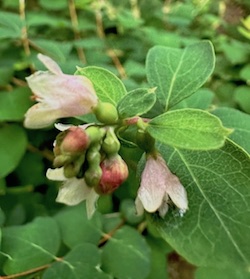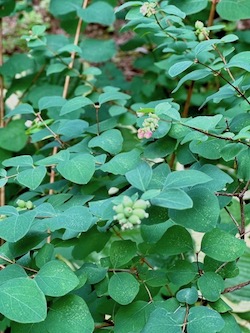Coralberry Shrubs: Their Development, a Few Years In
A few years ago, I purchased three shrubs called Proud Berry®—Symphoricarpos, or Coralberries. I had hoped that these shrubs would add color to my garden during the cold seasons. Now, with three summers (2022-24) in place in my yard, how are they doing? Well, suffice it to say, I am proud of the selection.
Coralberry shrubs are the pink cousins of the white Snowberry. When the garden turns from August green to autumnal tones, Snowberry and Coralberry shrubs add something different to the scenery. White berries, pink berries, blue-green foliage… their colors are different, and very welcome.
So what do these shrubs look like throughout the year? Well, let’s start with summer: Just when the pastels of spring become a memory, these shrubs show petite white and pastel pink blooms. This is followed by the late-summer emergence of berries in similar tones—all white for Snowberry, and pretty pink for Coralberry. Winter brings a new look to these deciduous shrubs, which lose their leaves in the cooler regions and turn to stick form. This winter state of the shrubs would not be unusual, but here is what makes Symphoricarpos different: many of the berries remain in clusters on the shrubs’ stick-like stems, looking like arrangements of pink baubles held mid-air, adding to winter wonder.
A Personal History
Now, a few years past purchase, my Coralberry shrubs, plants which I once wrote out as “Coral Berry” and now know better (the more accepted name is Coralberry)… well, they are thriving. Shown here, you will see a close-up of one of the shrubs in my yard, taken to highlight its tiny flowers in palest pink. This photo was taken this July (2024 photograph of a 2022 purchase). The foliage is lush in the picture; it was the same, even in the earliest days of summer. And all this new growth emerged from plants that were trampled this year while still in stick form, due to construction work done on a deck which sits close to where they are planted.

My Coralberry shrubs started out as plants that were about as tall as my hand is long. I had read that Symphoricarpos is a fast-growing shrub, but I had to experience this for myself. Sure enough, with just a few years’ growth in my yard plus the growth that was behind these Coralberry shrubs when they arrived at my doorstep post-purchase, sufficient time has passed to get these shrubs to the point of being very full and deck-high. At present, their tops align with the floor of the deck. Coralberry grows to an overall height of three- or four-feet tall, with stems that bend to form a mounded shape. My shrubs are at this point now, doing well despite a dry summer.
A mid-August photo is shared next, with slightly more growth to be seen and the morphing of flowers into berries.

The Berries
The photos indicate that Symphoricarpos berries take their time to develop. They do not appear too early, when they might go unappreciated. Instead, they wait until the very end of summer and early fall to show themselves in their best form. And when they show themselves, they appear in clusters that are visible and attractive. Last year, the clusters on my Coralberry shrubs were beautiful but not large; this year, I can already see that they will be more impressive in size—medium-sized berries, forming larger clusters of color. The berry clusters stand ready to delight the gardener in autumn and winter, times when unusual color is a treat to encounter.
So, more about the best feature of these shrubs—the berries…. The berries appear and then hold tight. Deer generally take no interest in them. Birds eat some, but I have found that they leave what seems to be an equal number of berries in place. And human gardeners… well, these berries are inedible to us, so we are no threat to the good looks of the shrubs.
To me, the white of a Snowberry and the pink of a Coralberry have a porcelain look to them. (True, not many of us want pink porcelain anymore—think of the washrooms of the past and you’ll know why—but in an ornamental berry, it is very desirable.) Photos and descriptions indicate that these berries can become bright, bright pink; however, mine stay paler, perhaps due to where I have planted my shrubs. Regardless, they are beautiful… very unusual.
For now, there is not much more to share. I am sure that next year, I will snap a few more photos as I marvel at the vitality and the growth of these shrubs.
Being overly proud can be unattractive. But Proud Berry® is attractive, and it has earned its right to be a source of pride in the garden.
Comments
{{ errors.first("comment") }}